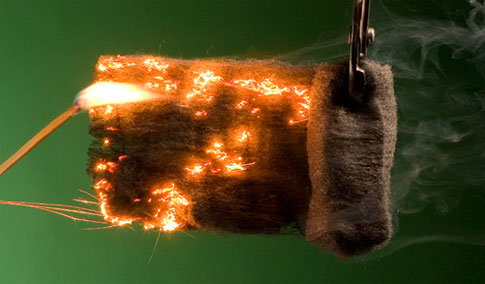

Wood fires are yellow, right? Well, typically, but not necessarily. All hot bodies emit “black body” radiation in a color spectrum that depends on temperature: red for fairly hot, orange for hotter, yellow for really quite hot, all the way up through white for, well, white-hot. Most wood fires burn at about yellow-hot.
But there’s also a second reason for the usual yellow color: something called the “spectral emission line.” Wood (along with most natural substances) contains sodium, which produces a yellow emission when ignited, regardless of the temperature.
A word from our attorney: Conduct this experiment with care, and always wear appropriate safety gear. Children should not attempt this experiment without adult supervision. Theodore Gray is a scientist trained in lab safety procedures. For more information on Gray’s scientific pursuits, visit his website.
If you mix substances with different spectral-emissions lines, they’ll burn different colors. Pyrotechnicians have a long list of chemicals that emit particular colors—combine lines with enough gunpowder to make a big bang and… boom! Fireworks are born.
One particularly fun chemical used in fireworks is copper (II) chloride, CuCl2, which has a strong blue emission line. Most fireworks-coloring chemicals produce tints only under fairly specific conditions, but with copper chloride you can just throw a handful into an ordinary wood fire (Achtung! Do not try this with a gas fire), and it will instantly turn the flames a fascinating mixture of blue, green and yellow. The color lasts pretty much as long as the logs do.
Is this safe? Well, sort of. Copper chloride is only moderately toxic, which is to say it’s about the same as ordinary wood smoke. (There’s a reason people have chimneys, and whether you’re using extra chemicals or not, wood smoke is not something you should breathe much of.) Be sensible, have an adult present, and you should be fine.
Another fun and reasonably safe substance to throw into fire is lycopodium powder. This ultrafine yellowish powder, available from fireworks- and magic-supply shops, is a classic substance employed by magicians and alchemists for centuries for impressing the public with a nice ball of fire. A pinch tossed or blown into a fire or candle flame will give off a huge, hot and loud fireball that vanishes as quickly as it appeared. I won’t say it’s harmless—this is real fire, and it could set things around it on fire—but on the other hand, it lasts for only a fraction of a second. (Achtung! Keep clothes and hair away from the fire).
Remarkably, lycopodium powder is not a chemical but actually the spores of a certain type of club moss. It burns fast simply because its texture is so fine. Almost any organic matter, even flour or corn dust, can burn explosively if it’s granular enough—lycopodium just happens to be a convenient all-natural fireball powder that is readily available.













